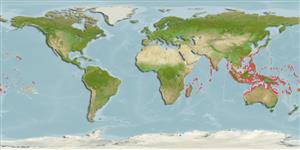Common names from other countries
>
Eupercaria/misc (Various families in series Eupercaria) >
Labridae (Wrasses) > Corinae
Etymology: Thalassoma: Greek, thalassa = the sea + Greek, soma = body; the colour of the sea (Ref. 45335).
Environment: milieu / climate zone / depth range / distribution range
Ecologia
marinhas associadas(os) a recifes; não migratória; intervalo de profundidade 0 - 15 m (Ref. 2334), usually 0 - 15 m (Ref. 27115). Tropical; 24°C - 28°C (Ref. 27115); 30°N - 32°S
Indo-Pacific: East Africa to the Line and Tuamoto islands, north to southern Japan, south to the Lord Howe and Austral islands.
Length at first maturity / Tamanho / Peso / Idade
Maturity: Lm 8.5 range ? - ? cm
Max length : 25.0 cm TL macho/indeterminado; (Ref. 129178); common length : 15.0 cm TL macho/indeterminado; (Ref. 6113)
Espinhos dorsais (total) : 8; Raios dorsais moles (total) : 12 - 14; Espinhos anais: 3; Raios anais moles: 11. Color pattern remains similar with growth with terminal males becoming gaudier than primary males (Ref. 37816). Pale green with 6 dark bars, last two as saddles over the tail. Head with pink bands radiating from eye in large adults (Ref. 48636).
Occurs in shallow lagoon and seaward reefs, slopes and along drop-offs to moderate depths. Occurs in small, loose groups (Ref. 48636). Feeds on benthic and planktonic crustaceans, small fishes, and foraminiferans.
Life cycle and mating behavior
Maturities | Reprodução | Spawnings | Egg(s) | Fecundities | Larvas
Oviparous, distinct pairing during breeding (Ref. 205).
Randall, J.E., G.R. Allen and R.C. Steene, 1990. Fishes of the Great Barrier Reef and Coral Sea. University of Hawaii Press, Honolulu, Hawaii. 506 p. (Ref. 2334)
Categoria na Lista Vermelha da IUCN (Ref. 130435)
CITES (Ref. 128078)
Not Evaluated
Ameaça para o homem
Harmless
Utilização humana
Pescarias: pouco comercial; Aquário: Espécies comerciais
Ferramentas
Relatórios especiais
Descarregue XML
Fontes da internet
Estimates based on models
Preferred temperature (Ref.
115969): 24.8 - 29.3, mean 28.4 (based on 2928 cells).
Phylogenetic diversity index (Ref.
82804): PD
50 = 0.5000 [Uniqueness, from 0.5 = low to 2.0 = high].
Bayesian length-weight: a=0.00955 (0.00610 - 0.01496), b=3.05 (2.92 - 3.18), in cm Total Length, based on LWR estimates for this species & Genus-body shape (Ref.
93245).
Nível Trófico (Ref.
69278): 3.5 ±0.37 se; based on food items.
Resiliência (Ref.
120179): Elevada, tempo mínimo de duplicação da população menor que 15 meses (K=1).
Fishing Vulnerability (Ref.
59153): Low vulnerability (16 of 100).
